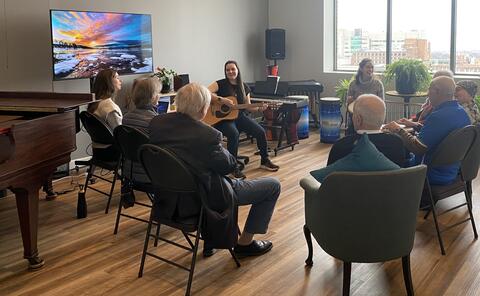
Session structure
How music therapy sessions are conducted.
From frequency to content, music therapy sessions adapt to clients’ needs.
Session outline
Music therapy sessions can take place in a group, dyad or individual setting. They usually occur on a regular basis, such as once a week, and are structured according to the needs of clients and the goals being addressed. The session duration can range from as little as 15 minutes to two hours in length, and group size can range from 3-4 to 10-15 participants.

Since 2020, the Institute has also explored online music therapy sessions to great success. These remote sessions have slightly different constraints. For example, we limit online group sessions to 4-6 participants to establish and maintain a strong connection with each person. The choice of modality (in person or online) is done based on discussions between the clients and music therapists.
What about musical ability?
Clients do not need any musical training or experience! Music therapists can propose instruments that are easy to play and adapted according to the participant’s ability. Music therapists also work with clients using song writing, singing and rhythmics using body percussions, for example by clapping their hands or stomping their feet.
Session structure
Music therapy sessions follow a structure that is determined in advance, according to the profile of participants involved (ex: children, adults or seniors), their abilities and objectives. The structure is similar from one session to another, providing a consistent and predictable environment. Sessions generally include an opening experience, one or more middle experiences, and a closing experience.
For example, a session might take place like this:
- Hello Song or welcoming musical introduction (opening experience)
- Create a personalized connection between music therapist and client by incorporating the client’s name in the song (especially with children)
- Check in with how the client is feeling
- Welcome the client to their musical space
- Maintain consistency with the melody and words so that the Hello Song is easily recognizable, helping ready the client to start their session
- Instrumental improvisation (middle experience)
- Propose a selection of instruments so the client can choose based on their mood, ability and state of mind, empowering them to exercise control over the session
- Musical interactions between the client and music therapist, initiated by either party
- Improvisations that are free-flowing and flexible
- Song choice, re-composition and discussion related to therapeutic goals (middle experience)
- The music therapist and client decide on musical styles and repertoire the client wishes to hear that day
- Selected music can be played live by the music therapist and client or through a pre-recorded version
- Discussion follows that addresses emotions, memories and issues to help the client make progress towards their goals
- Receptive music relaxation (middle experience)
- If clients need a moment to pause, a more relaxing experience can be offered with live or recorded music
- Calm, soothing music helps prepare the client for the end of their intervention
- Goodbye Song or musical closing (closing experience)
- Similar to the Hello Song, a personalized melody that incorporates the client’s name (especially with children)
- Maintain consistency with the melody and words so that the Goodbye Song helps prepare the client for the end of their session

